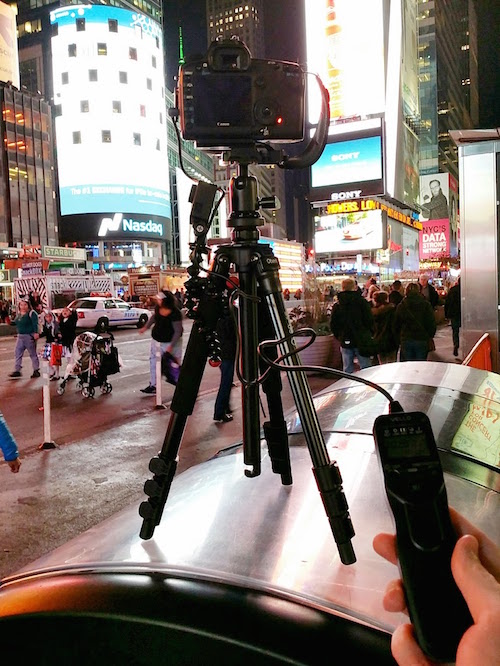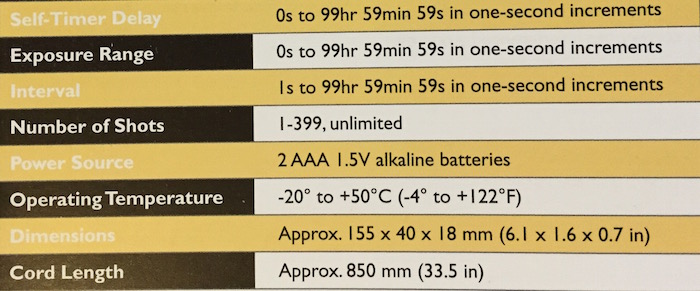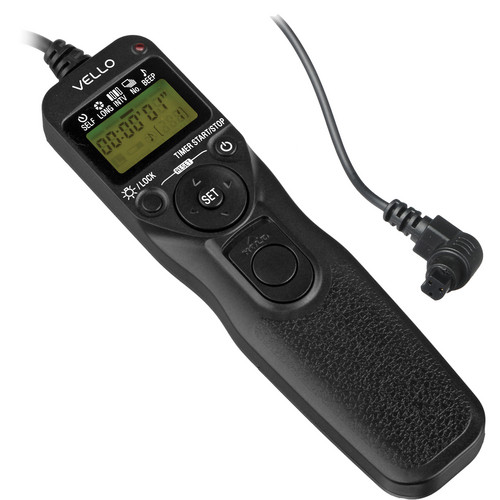The Vello ShutterBoss Version II is a remote/timer that is available for a number of DSLRs. This review addresses the remote as a whole; however, it is specifically tailored to its use with Canon DSLRs because that is the model I tested here.
The first thing you will notice about the Vello ShutterBoss when you compare it to the Canon Timer Remote TC-80N3 is the price. The Canon TC-80N3 runs $130, while the Vello model is under $50. It has virtually the same functionality as the Canon model for a fraction of the price.
Performance-wise, the Vello works fine. I have used both the Canon and the Vello models for time-lapse photography with easy results from both.

Most recently, I shot a few time-lapse sequences in Times Square with my 5D Mark II and the Vello ShutterBoss performed flawlessly. It connects via the Canon 3-pin connector, which is the same connector found on several Canon prosumer and pro DSLR models. The complete list (at the time of this post) is below.
Canon DSLR Compatibility with Vello ShutterBoss 3-Pin Model
- 10D, 20D, 30D, 40D, 50D
- 5D, 5D Mark II, 5D Mark III
- 6D
- 7D, 7D Mark II
- 1D, 1D Mark II, 1D Mark II N, 1D Mark III, 1D Mark IV, 1Ds, 1Ds Mark II, 1Ds Mark III, 1D X and 1D C
It has a useful backlight that aids viewing and adjusting the settings at night. It runs on 2 AAA batteries, which can last for about 60 days of continuous shooting with intervals of five minutes and exposures of 4 minutes, 56 seconds. When left on standby, it can last for up to 2 years. I believe that because I bought a Canon RC-1 remote (replaced by the RC-6) in 2005 and have yet to change the battery in it. At this point, I’m just waiting to see how long it lasts.
Unless you just want a Canon timer remote for your time-lapse shooting, I can’t come up with any reasons to justify the additional cost over the Vello ShutterBoss II remote. Again, Vello makes the ShutterBoss line of remotes for several DSLR models (including Nikon and Sony), which you can find here at B&H Photo.
I highly recommend this remote. At the very least, you should check it out closely before paying a premium price for a first-party remote.
[Update: To answer some questions that popped up in the comments, I’ve included a photo below of the manual that shows the specs of the timer and interval shot options. Hopefully, this will help clear up any confusion.]




I have used them for years and have never had an issue. Even have had the same results with the off-brand versions of these direct from overseas as well – available on Amazon or eBay for even additional savings. They can be had for around $20 each if you do not mind waiting for shipping.
Does it take AA batteries, or AAA batteries?
Just asking, because most remotes (Canon and 3rd party) that I’ve had use AAA batteries.
Two AAA batteries.
Got it. FYI – your post above mentions AA batteries.
Sorry about that. Thanks for noticing. I’ve corrected the post.
I’ve found the Canon limited in the number of shots you can take. Does the Vello have any larger values; specifically number of exposures?
What limitations have you found? I have both the Canon and a 3rd party remote, and they seem to be equivalent.
If I recall it was limited to 99 exposures.
I think all of these types of remotes are limited to 99 exposures (at least in my limited experience). If I need to go beyond 99, I’ll just use my TriggerTrap instead.
I was able to capture several hundred images at specific intervals with no problems. The same is true with the Canon TC-80N3.
Can you share the process?
You can do a time-lapse, bulb or self-timer custom setting depending on what you are shooting for. It’s pretty straight-forward and it comes with a detailed instruction book.
I’ve included a photo of the specs showing the capabilities in the updated post above.
The Shutterboss can be programmed to take 1-399 photos and then stop. Alternatively, if you toggle one more than 399 (or 1 less than 1) 2 lines will appear. This setting is infinity. The camera will continue to shoot at the interval selected until you stop it, run out of memory or run out of battery.
Thanks for the clarification Abe.